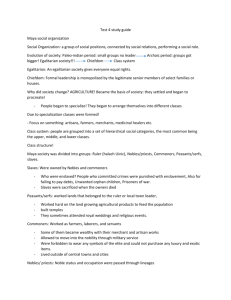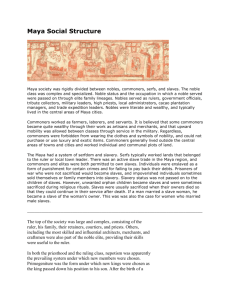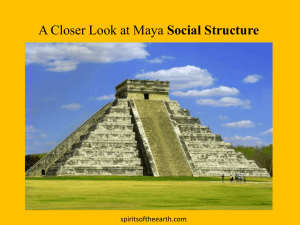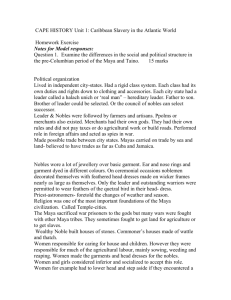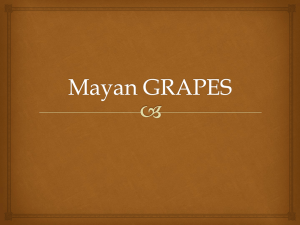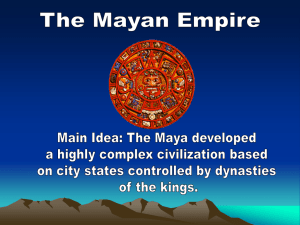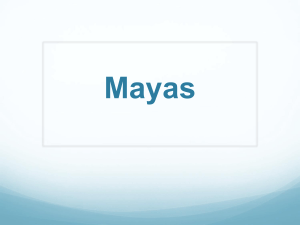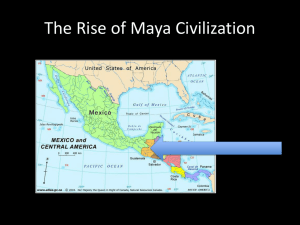Mayan Government
advertisement
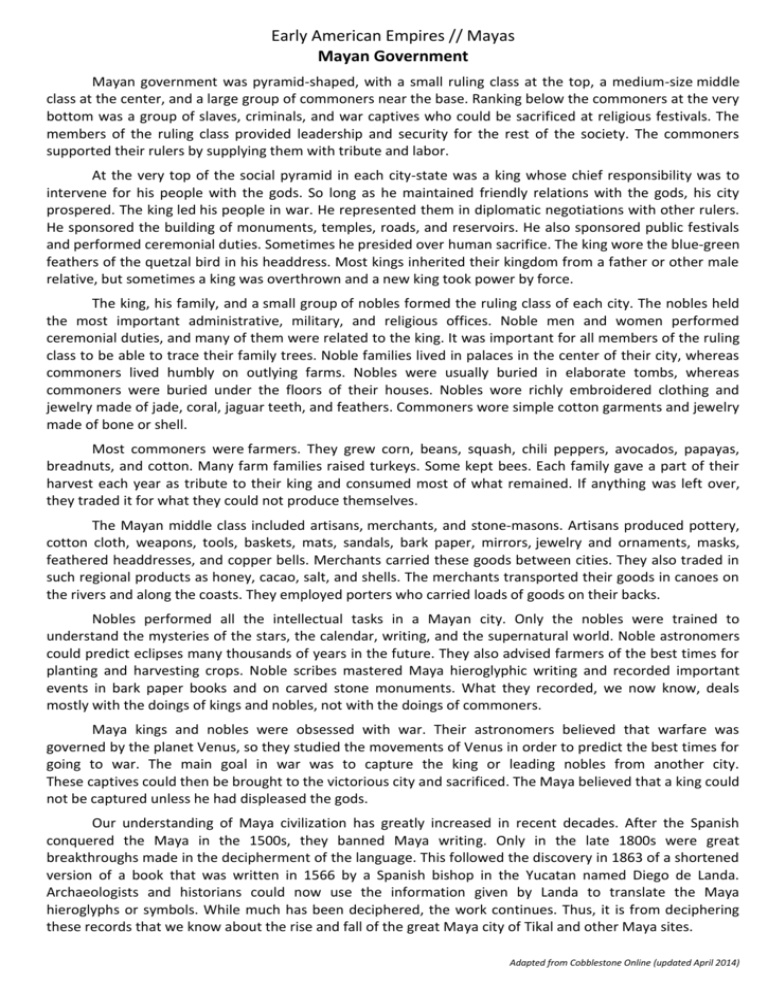
Early American Empires // Mayas Mayan Government Mayan government was pyramid-shaped, with a small ruling class at the top, a medium-size middle class at the center, and a large group of commoners near the base. Ranking below the commoners at the very bottom was a group of slaves, criminals, and war captives who could be sacrificed at religious festivals. The members of the ruling class provided leadership and security for the rest of the society. The commoners supported their rulers by supplying them with tribute and labor. At the very top of the social pyramid in each city-state was a king whose chief responsibility was to intervene for his people with the gods. So long as he maintained friendly relations with the gods, his city prospered. The king led his people in war. He represented them in diplomatic negotiations with other rulers. He sponsored the building of monuments, temples, roads, and reservoirs. He also sponsored public festivals and performed ceremonial duties. Sometimes he presided over human sacrifice. The king wore the blue-green feathers of the quetzal bird in his headdress. Most kings inherited their kingdom from a father or other male relative, but sometimes a king was overthrown and a new king took power by force. The king, his family, and a small group of nobles formed the ruling class of each city. The nobles held the most important administrative, military, and religious offices. Noble men and women performed ceremonial duties, and many of them were related to the king. It was important for all members of the ruling class to be able to trace their family trees. Noble families lived in palaces in the center of their city, whereas commoners lived humbly on outlying farms. Nobles were usually buried in elaborate tombs, whereas commoners were buried under the floors of their houses. Nobles wore richly embroidered clothing and jewelry made of jade, coral, jaguar teeth, and feathers. Commoners wore simple cotton garments and jewelry made of bone or shell. Most commoners were farmers. They grew corn, beans, squash, chili peppers, avocados, papayas, breadnuts, and cotton. Many farm families raised turkeys. Some kept bees. Each family gave a part of their harvest each year as tribute to their king and consumed most of what remained. If anything was left over, they traded it for what they could not produce themselves. The Mayan middle class included artisans, merchants, and stone-masons. Artisans produced pottery, cotton cloth, weapons, tools, baskets, mats, sandals, bark paper, mirrors, jewelry and ornaments, masks, feathered headdresses, and copper bells. Merchants carried these goods between cities. They also traded in such regional products as honey, cacao, salt, and shells. The merchants transported their goods in canoes on the rivers and along the coasts. They employed porters who carried loads of goods on their backs. Nobles performed all the intellectual tasks in a Mayan city. Only the nobles were trained to understand the mysteries of the stars, the calendar, writing, and the supernatural world. Noble astronomers could predict eclipses many thousands of years in the future. They also advised farmers of the best times for planting and harvesting crops. Noble scribes mastered Maya hieroglyphic writing and recorded important events in bark paper books and on carved stone monuments. What they recorded, we now know, deals mostly with the doings of kings and nobles, not with the doings of commoners. Maya kings and nobles were obsessed with war. Their astronomers believed that warfare was governed by the planet Venus, so they studied the movements of Venus in order to predict the best times for going to war. The main goal in war was to capture the king or leading nobles from another city. These captives could then be brought to the victorious city and sacrificed. The Maya believed that a king could not be captured unless he had displeased the gods. Our understanding of Maya civilization has greatly increased in recent decades. After the Spanish conquered the Maya in the 1500s, they banned Maya writing. Only in the late 1800s were great breakthroughs made in the decipherment of the language. This followed the discovery in 1863 of a shortened version of a book that was written in 1566 by a Spanish bishop in the Yucatan named Diego de Landa. Archaeologists and historians could now use the information given by Landa to translate the Maya hieroglyphs or symbols. While much has been deciphered, the work continues. Thus, it is from deciphering these records that we know about the rise and fall of the great Maya city of Tikal and other Maya sites. Adapted from Cobblestone Online (updated April 2014)
